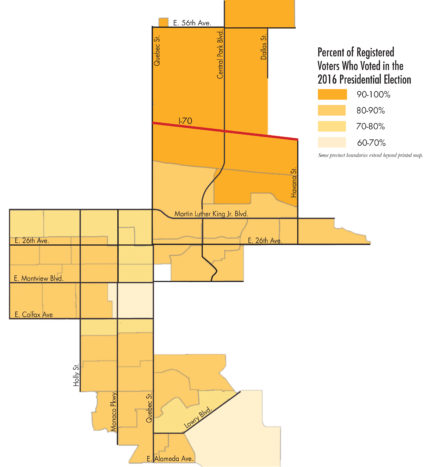We have one of the highest turnout rates in Denver.
Eighty percent of registered voters in the Front Porch distribution area cast ballots in the 2016 Presidential election.That would a “B-” if assigned a traditional letter grade. Compare that to the “C” (76%) of Denver, the “C-” of Colorado (72%), and the “F” (56%) of the United States—and that “B-” that stands pretty tall.
In fact, during the 2016 election, northeast Denver’s hard fought “B-” stood as one of the highest voter turnout rates in Denver. Two precincts in Stapleton, shown in dark orange on the map, set the curve and tied at 92%, the highest turnout of registered voters in the city.1
While voter turnout for the last 35 years in the United States remained within a stable range, according to data from the U.S. Census, the same period saw increasing numbers in Colorado.
Legislation that allows Coloradans to register online up to and including election day, vote at any polling place instead of at assigned precincts, and receive ballots by mail have created an environment in the state where it is easier to register and vote than in many other states. These factors, combined with all the other factors that determine who votes in individual elections, have resulted in a Colorado voting rate that compares favorably to other developed nations where automatic registration or even compulsory voting leads to high levels of election participation.
But, while Colorado and these northeast Denver precincts may stand as prime examples of participation in the United States, they do follow the national trend of lower voter turnout in midterms—and much lower turnout in primaries.
The 2018 open primary, which allowed unaffiliated voters to choose either the Democratic or Republican ballot, did see a dramatic rise in turnout. But while 36% is far better than 21% and 22% seen in 2016 and 2014 respectively, these primary numbers are still paltry compared to presidential races.




0 Comments